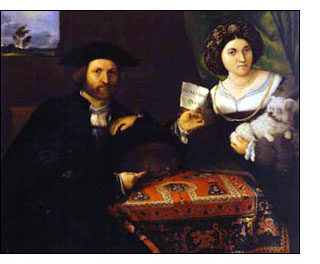WASHINGTON, Oct. 8 -- Contemporary artist David Hockney caused a stir in 1999 with his controversial theory that early Renaissance artists used optical devices like the camera obscura or concave mirrors to project scenes onto their canvases for tracing. This, he believes, might help explain the sudden emergence of more realistic painting in the early 15th century. It would also mean that artists began using optical lenses even earlier than scientists did: The microscope and telescope weren't invented until the 1590s.
Now one of Hockney's chief scientific allies is facing off against one of his most vocal detractors in a session on optics and art at OSA's Frontiers in Optics meeting, to be held Oct. 10-14 in Rochester, N.Y. Physicist Charles Falco is a professor of optics at the University of Arizona who tested Hockney's hypothesis by analyzing measurable distortions in several paintings from the 16th century. David Stork is a consulting professor of electrical engineering at Stanford University, who says he initially approached Hockney's theory with an open mind.
"It was only after finding persistent flaws and simpler alternative explanations for the phenomena that I began to seriously doubt the theory," he says.

Family Portrait, Lotto, Lorenzo (oil on canvas). Italy, 1523/1524 (The Hermitage, St. Petersburg, Russia)
|
One subject of contention is Italian painter Lorenzo Lotto's "Family Portrait" (1523/1524), currently on display at The Hermitage in St. Petersburg, Russia. The geometric pattern of the carpet loses focus as it recedes into the painting and there are two vanishing points clearly visible in the fabric's border. The keyhole pattern should have receded in a straight line, with a single vanishing point corresponding to a single viewpoint. Instead, there is a kink in the pattern, which then continues in a slightly different direction. Hockney and Falco see this as evidence that Lotto used a lens to project an image of the carpet's pattern, but then found he could not keep it all in focus at the same time. So Lotto refocused the lens to complete the back portion of the carpet, changing the vanishing point.
Not so, says Stork. He maintains that the Hockney and Falco's finding is based on the assumption that the keyhole pattern is symmetrical. He conferred with carpet historians, who said that the patterns in so-called "Lotto carpets" are asymmetric, and the degree to which the pattern deviates matches the perspective anomalies in Lotto's painting.
Or consider the chandelier depicted in Flemish painter Jan van Eyck's 1453 painting "Portrait of Arnolfini and His Wife," now at the National Gallery in London. Hockney has argued that van Eyck used a concave mirror to project an image onto the canvas and trace the outlines of the chandelier to get it in proper perspective. The problem, says Stork, is that the chandelier isn't in perfect perspective. He and Antonio Criminisi, a researcher for Microsoft in Cambridge, England, analyzed a digitally scanned image of the chandelier in 3D, rotating the six arms of the chandelier and overlapping them to see if they aligned. They didn't. He and Criminisi even hired British realist painter Nicholas Williams, who painted a similar chandelier by eye that wasn't in perfect perspective but was still more accurate than van Eyck's. To Stork, this is conclusive evidence that the chandelier was painted by eye.
Falco disagrees. He claims that Stork has fundamentally misunderstood how early artists would have used lenses and other optical aids: not to painstakingly trace an object's image and render it exactly, as in a photograph, but to capture points of perspective and a rough outline of certain objects that might otherwise be more difficult to capture on canvas. This would include van Eyck's ornate chandelier, as well as patterns on fabrics following folds, folded draperies, architectural curves, and foreshortenings in rooms. Then the artist would turn the canvas over and fill in the details later by eye.
"Paintings are not photographs," he says. "If you assume that the chandelier is a photograph, that's a wrong assumption, and you're going to reach the wrong conclusion."
In fact, "Everything that Stork has said is wrong, misleading, or irrelevant -- or all three," Falco says, pointing to Stork's contention that lamps and candles did not provide sufficient illumination to project images with the crude lenses available in the early 16th century. It's true that the first documentary evidence of a projection of an illuminated object onto a screen by a concave mirror or converging lens dates back to the beginning of the second half of the 16th century. But Falco and Hockney have always maintained that artists of that era used sunlight to project the images -- an optical effect that has been known for millennia. Stork himself concurs that "projections of bright light sources such as the sun or candle flames may have occurred earlier."
There's one point on which all three men can agree: The use of optics by any artist does not constitute "cheating," or in any way lessen his or her artistic abilities. Such misconceptions "cloud the discussion," says Stork. The use of optical aids "diminishes no great artist," Hockney writes in his book, Secret Knowledge: Rediscovering the Lost Techniques of the Old Masters (2001, Studio Books).
For his part, Falco says he always considered van Eyck a genius: "I underestimated him."
For more information about OSA's annual meeting, visit: www.osa.org/annual